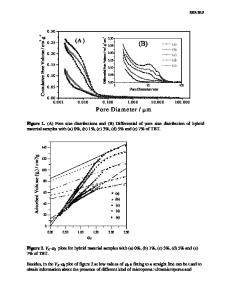Multilayer Hybrid Structure of ZnO Nanorod Arrays Imbedded in TiO 2 Network as Photoanode
- PDF / 270,893 Bytes
- 6 Pages / 432 x 648 pts Page_size
- 58 Downloads / 329 Views
Multilayer Hybrid Structure of ZnO Nanorod Arrays Imbedded in TiO2 Network as Photoanode Chan-yan Huang1, Yan Sun1, Xin Chen1, Ning Dai1 1 National Laboratory for Infrared Physics, Shanghai Institute of Technical Physics, Chinese Academy of Sciences, Shanghai 200083, China ABSTRACT We developed a multilayer hybrid structure by imbedding ZnO nanorod arrays in TiO2 network for each layer, for the pourese of taking ZnO nanorods as the highway of electron transport. ZnO nanorods can be prepared by hydrothermal process, which is simple, low cost and easy control. The ZnO nanorod arrays were grown by reported hydrothermal method, then TiO2 network was constructed by spin-coating titanium precursor sol on ZnO nanorod arrays and calcining. The electrochemical impedance spectrum measurements were taken to study the electrical properties of this kind of hybrids, and the results indicated that the effective electron lifetime reaches a magnitude of microsecond which is similar to the pure ZnO nanorod arrays. It reveals to us that ZnO nanorods may dominate the electrical properties of this nano-hybrid structure. INTRODUCTION As the exploring of photoelectric conversion, photoelectrode with mesoporous TiO2 used in dye-sensitived solar cells(DSSCs) gain a lot of achievement after the boosting of low-cost high-efficiency device by Grätzel in 1991 [1]. On one hand, new compounds have been synthesized and applied to nanostructures. In particular recently, Aswani Yella etc. measured a power conversion efficiency of 12.3% under simulated AM1.5 global sunlight based on TiO2 nanocrystal photoanode, with new custom synthesized donor-p-bridge-acceptor zinc porphyrin dye as sensitizer and cobalt (II/III) as electrolyte redox shuttle [2]. On the other hand, improving electron transport capacity is another key point to increase the power conversion efficiency of the DSSCs. ZnO one dimensional nanostructures, such as nanorod or nanowire arrays, peform faster electron transport by two orders of magnitude than electrons in mesoporous electrode with a similar lifetime [3,4]. The electron effective diffusion length (LD) in ZnO nanowire array photoanode is ~100ȝm [3-6], which is much larger than that in nanoparticles film with LD ~10-35ȝm [7]. Chengkun Xu and his group overcame the problem that hydrothermal method is hard to achieve high aspect ratio of ZnO one-dimensional structure, they synthesized multilayer of ZnO nanowire arrays with alternate cycles of growth [8]. However, the density decreases as the alternate cycles increase, which is not of benefit to the increase of surface area. Here we propose a hybrid structure of ZnO nanorod arrays imbedded in TiO2 network, taking ZnO nanorods as the highway of electron transport. ZnO nanorods can be prepared by hydrothermal process, which is simple, low cost and easy control. We develop a multilayer hybrid structure by imbedding ZnO nanorod arrays in TiO2 network for each layer. The ZnO nanorod arrays were grown by reported hydrothermal method, and then TiO2 network was constructed by spin-coating ti
Data Loading...











